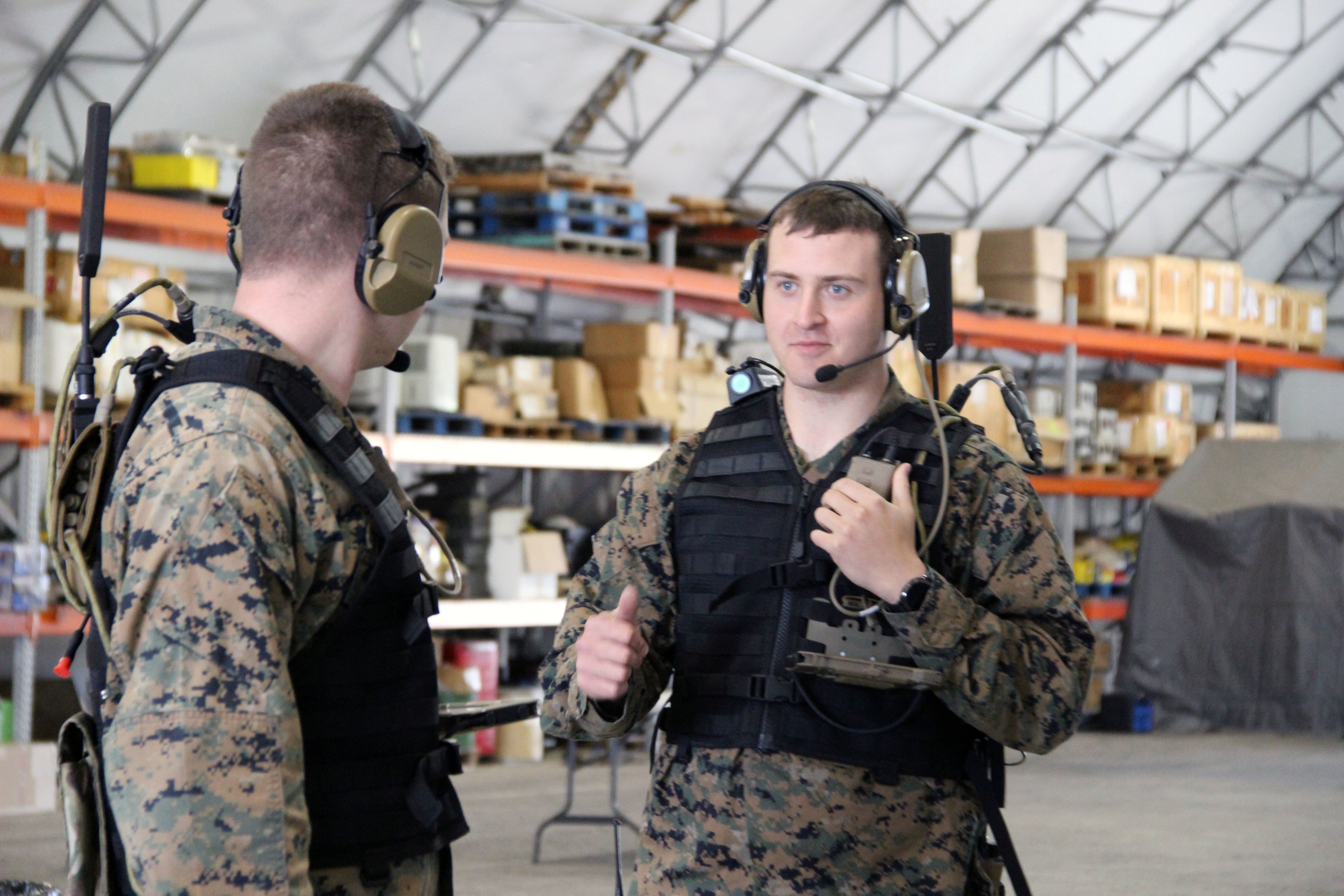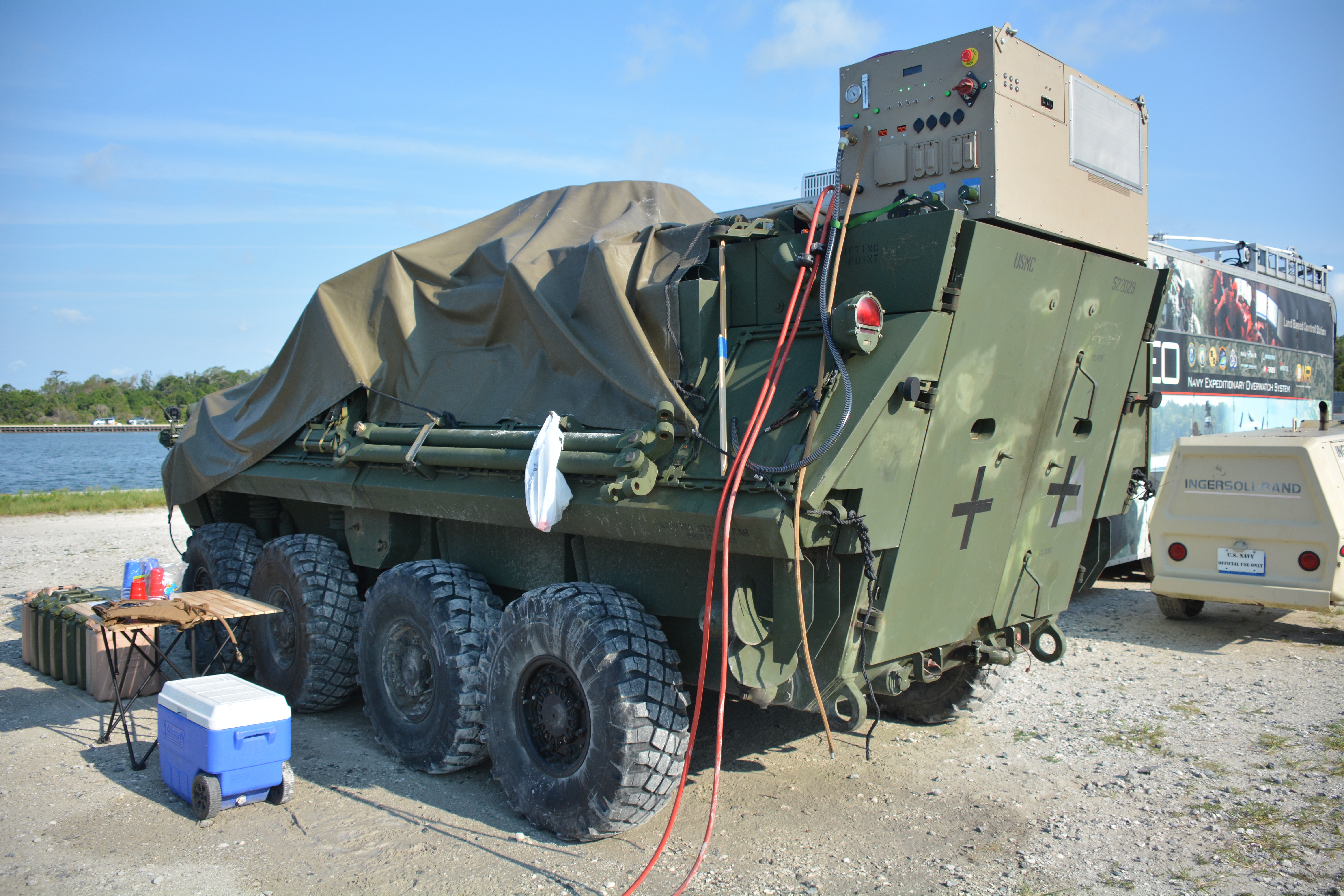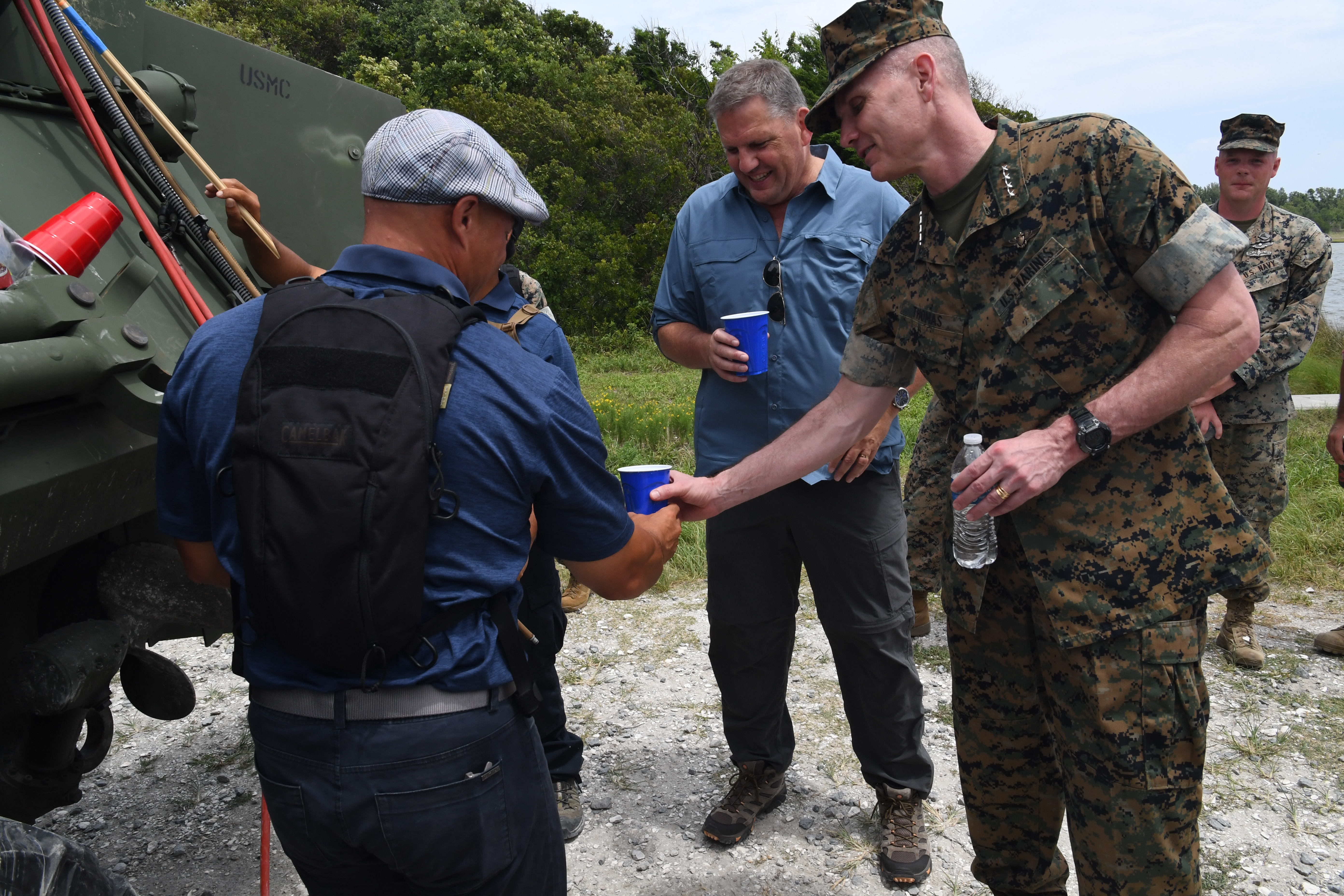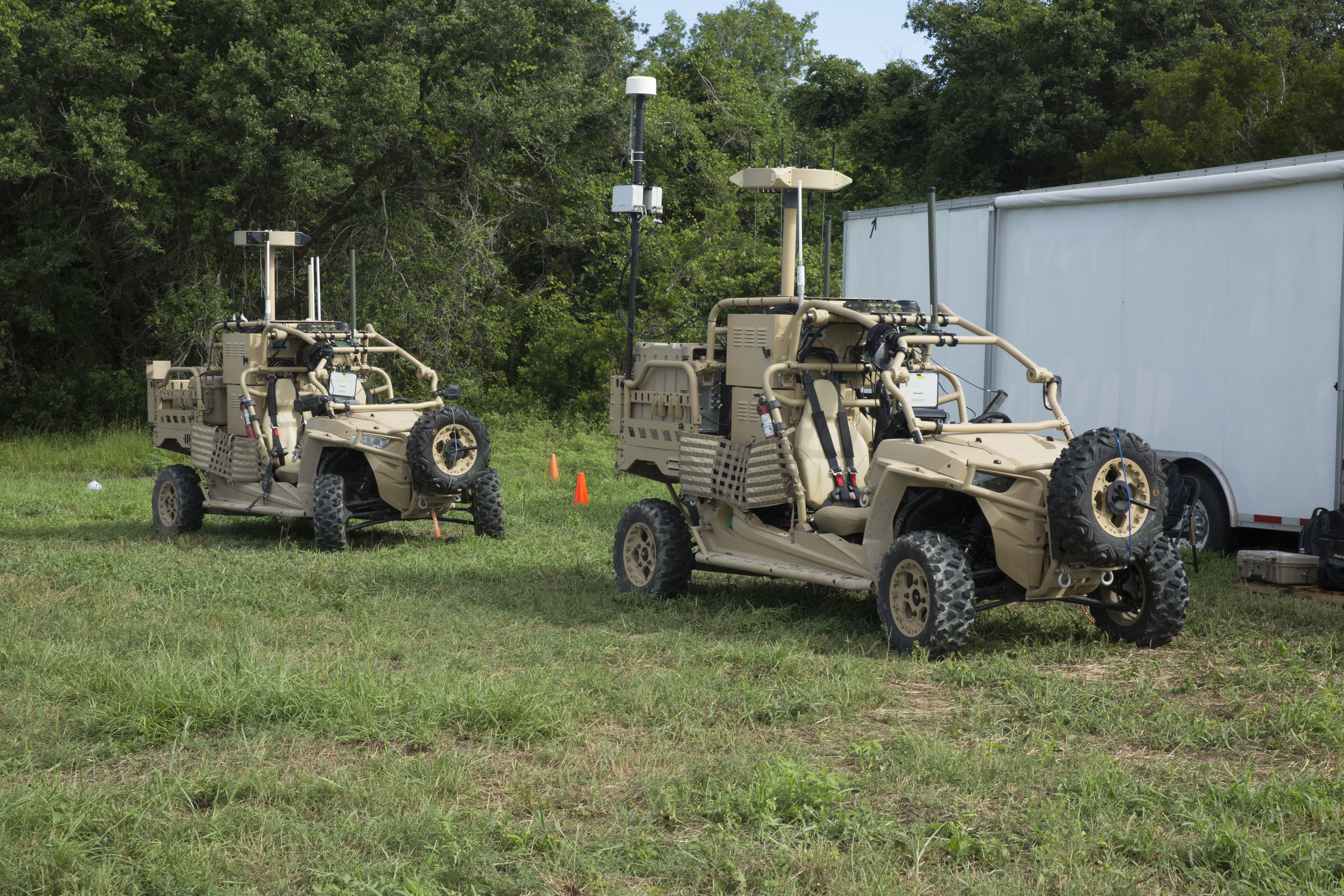
THE PENTAGON – The Navy and Marine Corps are using their tech experimentation series to better understand how to execute new warfighting concepts and to see how evolving gear may change those concepts.
In two Advanced Naval Technology Exercises (ANTX) events this year, one on each coast, the services examined more than 100 technology prototypes that could revolutionize how they fight future wars – ones that will be distributed over large swaths of sea and land, and ones fought in a communications-denied environment. But in seeing these technologies and trying to apply them to their new warfighting strategies as written today, the services are discovering capability gaps they didn’t know they had or seeing where investing in one capability could obviate another seemingly unrelated tech requirement.
“When we start looking at what that future fight looks like and those things we need to enable it, this venue has really become a great way to start ferreting out those technologies that will enable our Marines and sailors to do that,” Maj. Gen. Mark Wise, the deputy commander of the Marine Corps Combat Development Command and assistant deputy commandant of the Marine Corps for combat development and integration, told reporters at a roundtable last week.
James Geurts, assistant secretary of the Navy for research, development and acquisition – who traveled with Wise and others to the most recent ANTX event at Camp Lejeune, N.C., in mid-July – said the event included 53 technologies from 32 organizations, with more than 1,900 assessments made by operational sailors and Marines as well as requirements and acquisition professionals.
“What it really allows us, at a very low cost for everybody, a way to get ideas gelled and feedback. So anybody that brought equipment there got assessments from many of the folks who were there, and they can use that to modify their product or improve their product,” Geurts said.
“We got exposure to cutting-edge stuff that we may not have known we had a requirement for until we saw it. And then we were able to, kind of in an innovative setting, in a field setting, inform everybody. My requirements partner here may not have been thinking about a particular way to write a requirement because we didn’t know the technology was out there.”

With a focus on maneuver, force protection and logistics, Wise said the event was meant to address some of the top challenges that new concepts – Expeditionary Advance Base Operations, Littoral Operations in a Contested Environment, and Distributed Maritime Operations – will present the naval force.
Technologies that showed promise included autonomous logistics vehicles that could move small and large packages of goods around in the air, on the ocean surface and on ground; command and control systems that push more information to lower echelons operating away from headquarters; meshed communications systems that would keep Marines connected even in a satellite-denied environment; and water-purification and other “foraging” capabilities that would reduce the need for water, energy and other supplies to be moved around the battlefield.
In an April ANTX in California, 52 prototypes were tested in an exercise and more than 100 total were evaluated by operators, with a similar focus on unmanned systems and battlefield sensing and targeting.

Of course, the Navy and Marine Corps do not want to experiment for the sake of experimenting, or prototype technology for the sake of prototyping. They are hyper-focused on the future environment they expect, as laid out in the National Defense Strategy, the recent Commandant’s Planning Guidance released by new Commandant Gen. David Berger, and other service and Pentagon documents.
To ensure the ANTX events remained focused on the right problems, Wise said the warfighting scenario the ANTX participants had to plug into mirrored the same scenarios that warfighters use in their own training events.
“What’s interesting from my perspective is, there’s a fairly detailed feedback mechanism where we look at, for this operational scenario, we think we need these kinds of technologies: we need to be able to sense like this, we need to be able to move like this, we need to be able to shoot or be lethal in this area. But what the relative value of each one of those is is what we really start ferreting out,” Geurts said.
“And so as we understand and get technologies and ideas in and we start kind of running through the scenarios, you could start saying, if I could see 10 times further then I could do these jobs much easier. Or if I could see 10 times further, it’s not going to matter – so you can start assessing the relative priority of all the different components to an operational concept. And then the ANTX helps give you feedback on the achievability of each one of those elements. … The challenging part is figuring out how much of what and in what priority. The more sensing you have, the more logistical challenge you have for power, so figuring out that tradeoff.”
The fact that ANTX takes place in the field instead of in a conference room helps understand those tradeoffs, Geurts and Wise said. For example, having additional sensing and communications capability is of great value to the warfighter, but they could create additional logistics considerations, with requirements for power and spare parts. Some tools, such as autonomous logistics vehicles or water purification systems, in theory would reduce the logistics burden on a force but, if executed incorrectly, could actually require more spare parts or more trained personnel to accompany the gear around the battlefield. Making those tradeoffs on paper is hard, but making them in the midst of a warfighting exercise leads to smarter decisions.

Assessing these technologies in the field also leads to some on-the-spot innovations to help address challenges that technologists might not have thought about when developing their gear.
“What’s remarkable to me is what gets invented in two or three days of, somebody brings the peanut butter, somebody brings the chocolate, and suddenly they start talking in an environment where it’s safe to work together, and then you get discoveries that you wouldn’t normally have thought of in advance,” Geurts said.
Among the technologies that most interested Navy and Marine leadership this time around were a truck-mounted drinking water purification system as well as a tool that could be carried via an MRZR truck and provide a headquarters-level common operational picture of the battlefield with target-quality data that small units could use.
“The days of having this big COP, common operational picture, at only one location and trying to push some information out, those days are really coming to an end. We’re pushing that kind of level of information, down to targeting quality information, all the way to the user. So you’re able to make decisions much much faster because everyone has a fairly good picture of what’s going on,” Wise said.
“Now what we’re able to do is take that form factor and put it on something that might be the size of an MRZR that fits in the back of a MV-22 and goes with that Marine rifle company or squad into the battlespace. And all the sudden that guy has got the same situational awareness that the three-star general has at the [Marine Expeditionary Force] headquarters,” he continued.
“Now, that MEF commander’s looking at it and so is that young captain who may be maneuvering the the battlespace,” and if the captain is equipped with both commander’s intent and an accurate and detailed common operational picture, small unit leaders can make much better decisions.
Asked how this concept fits in with the notion that the future battlefield may be communications-denied, Wise said that he also saw a lot of interesting meshed network technologies that make him confident in the Marine Corps’ ability to keep the right people connected during a fight.
“Users become repeaters. There was a lot of that technology out there where I’m not really relying on a satellite at all for some of that. Because I become the satellite, and so does the next guy to me, and the guy a ridgeline away, or an [unmanned aerial vehicle], or a balloon, you name it. It becomes this exponential way to now expand this comm bubble that’s not just pushing voice, it’s pushing data, it’s pushing all kinds of things,” the general said. Noting that an adversary could only deny communications in a finite area at one time, he said, “if I can push that information from an area that’s not being denied through a meshed capability, then you really start talking about some neat stuff.”





